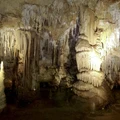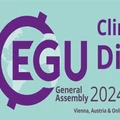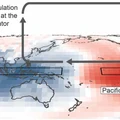
Michael Sigl
- 2024
- Hans Oeschger Medal
The 2024 Hans Oeschger Medal is awarded to Michael Sigl for his innovative contributions, which improved ice core chronologies and illuminated the impacts of volcanic eruptions on climate and societies.

European Geosciences Union
Division on Climate: Past, Present & Future
President: Kerstin Treydte
(cl@egu.eu)
Deputy President: Gabriele Messori
(gabriele.messori@geo.uu.se)
The Division on Climate: Past, Present & Future (CL) is one of the larger divisions of the European Geosciences Union. It pools from many disciplines and consequently has many co-organised sessions with other divisions at the EGU General Assembly. The division is very interdisciplinary and covers climate variations on all time scales. CL includes the study of any kind of climate archive from rocks to ocean cores, speleothems, ice cores, chronicles, to instrumental records to name a few. Besides observations, climate modelling on all time scales from the deep past to the future are areas covered by the division. Any aspect of the climate system falls into the realm of the division e.g. atmosphere, ocean, biosphere, cryosphere, and geology. Themes focus on the climate on Earth but may also expand other planets or the Sun.
A recently published article by Armstrong Mckay et al. in Science updates the assessment of major climate tipping elements and their possible tipping points first proposed by Lenton et al. (2008). "Climate tipping points occur when change in a part of the climate system becomes self-sustaining, locking in major negative impacts affecting millions of people. Our results provide strong scientific support for rapid emission cuts in line with the Paris Agreement's more ambitious aim of limiting warming to 1.5°C, which would reduce the chances of triggering multiple climate tipping points" says lead-author Armstrong McKay. There have been major scientific advances since the original paper and several new tipping elements have been proposed (e.g. the East Antarctic ice sheet). The article identifies nine global “core” tipping elements and seven regional “impact” tipping elements, along with their climate tipping point thresholds. With further warming heading towards 1.5 - 2°C above preindustrial levels, the authors determine that at least six of these tipping elements will likely pass their critical thresholds. These include the collapse of the Greenland and West Antarctic ice sheets, the demise of low-latitude coral reefs and widespread abrupt permafrost thaw.
References
Armstrong McKay, D.I., Staal, A., Abrams, J.F., Winkelmann, R., Sakschewski, B., Loriani, S., Fetzer, I., Cornell, S.E., Rockström, J., Lenton, T.M., 2022. Exceeding 1.5°C global warming could trigger multiple climate tipping points. Science 377, eabn7950. doi:10.1126/science.abn7950 Lenton, T.M., Held, H., Kriegler, E., Hall, J.W., Lucht, W., Rahmstorf, S., Schellnhuber, H.J., 2008. Tipping elements in the Earth’s climate system. Proceedings of the National Academy of Sciences 105, 1786–1793. doi:10.1073/pnas.0705414105
Climate system is one of the most complex physical systems on this planet. To understand what changes in our climate system can trigger an event, we require excellent understanding of various sub-systems of Earth, an outstanding modelling framework that combines these sub-systems, and enormous computational power. Today we have several coupled Earth system models that can simulate the climate of our planet. This would not have been possible without the pioneering efforts of Prof. Syukuro Manabe and Prof. Klaus Hasselmann, who have driven the climate research and demonstrated that the greenhouse gas emissions is responsible for climate change. For their ground-breaking research that has helped us model and understand one of the most complex systems on this planet, both of them have been awarded 1/4th of the 2021 noble prize for Physics.
This is for the first time that climate scientists have been awarded the most prestigious award in sciences. As climate scientists, we are proud and thrilled to receive this news. The award is timely and it demonstrates the importance of climate research for society. We hope that this award will ignite and enhance public debate on climate change, which should push our leaders to take strong steps in reducing the greenhouse gas emissions, protecting the vulnerable, and ensuring a safer planet for everyone. More news can be found here: EGU press release (7.10.2021) and in a blog post of NP division

The 2024 Hans Oeschger Medal is awarded to Michael Sigl for his innovative contributions, which improved ice core chronologies and illuminated the impacts of volcanic eruptions on climate and societies.

The 2024 Milutin Milanković Medal is awarded to Peter U. Clark for exceptional contributions to reconstructing and understanding how the past climate, ice sheets and sea level responded to perturbations, with a perspective on future committed changes.

The 2024 Division Outstanding Early Career Scientist Award is awarded to Maria A. A. Rugenstein for outstanding research in climate dynamics and the ocean’s influences on atmospheric feedbacks.

The 2023 Milutin Milanković Medal is awarded to Bette L. Otto-Bliesner for her exceptionally outstanding contribution to modelling the earth system from deep-time to glacials and interglacials, and leading pioneering work to use palaeoclimate for better future projection.

The 2023 Hans Oeschger Medal is awarded to Hugues Goosse for wide and significant contributions to palaeoclimate modeling and pioneering work in data assimilation in palaeoclimatology.

The 2023 Outstanding Student and PhD candidate Presentation (OSPP) Award is awarded to Ali Serkan Bayar Greater rate of climate zone change in CMIP6 Earth System Models due to stronger warming rates

The 2023 Outstanding Student and PhD candidate Presentation (OSPP) Award is awarded to Anika Donner Warmer and wetter past interglacials in northeast Greenland recorded in speleothems

The 2023 Arne Richter Award for Outstanding Early Career Scientists is awarded to Wim Thiery for his broad-ranging research contributions on the topics of extreme climate events, climate change impacts, energy meteorology, water resources, and land-atmosphere interactions.

To understand Earth’s changing climate, scientists often examine how the climate has varied in the past, by studying geological records. These records allow us to reconstruct past climates and help us predict planet’s responses to different climate forcings. In this context, it has long been thought that past ice ages on Earth were relatively dry, whereas the warm periods between ice ages were believed to be comparatively wet. For many years, this paradigm has shaped the interpretation of habitat availability …

Dear community of climate enthusiasts and EGU lovers, We know that being part of the EGU is not just about staying in the loop with the latest geoscience works – especially when it comes to our all-time favorite realm of sciences: climate sciences 🤩. It is also an amazing opportunity to spark exciting collaborations and expand your network with scientists from all over Europe and the world. EGU is not just a congress; it is it’s a vibrant community powered …

What is the Walker Circulation? The El Niño Southern Oscillation, or ‘ENSO’, is one of the major causes of year to year variability in Earth’s climate. ENSO is characterised by: changes in the temperature of the ocean’s surface in the tropical Pacific Ocean, and by changes in atmospheric circulation in an east-west direction above the Pacific Ocean. Number two in that list is what makes ENSO so impactful. Because the Pacific Ocean is so enormous, changes in atmospheric circulation over …

– A debate among scientists and its impact on us The epoch of humans (and their obvious intervention in the Earth system) In order to understand what the ‘Anthropocene’ means for us, we need to define first what it actually is. This poses a rather complex question in itself, as various disciplines have given the term rather different and alternative definitions. For instance, the public media uses the term ‘Anthropocene’ to describe the undeniable impact of humans on the environment …
In our March Issue, we are getting ready to make new connections at EGU24 which will be starting in just over two weeks! Learn about how find your personal collection of science interests and make the most of our biggest hybrid General Assembly yet!
Get all the insider tips form EGU’s Events Manager Jane Roussak as well as many othe guides and helpful articles on the EGUblogs, watch our recorded EGUwebinar on navigating the General Assembly with our Early Career Scientists and if you are a convener, don’t miss our EGUwebinar on 2 April that will help you be fully prepared for your session.